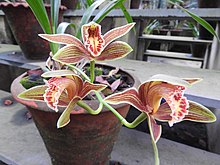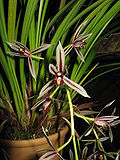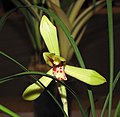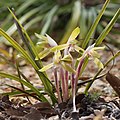Cymbidium
| Boat orchids | |
|---|---|

| |
| Cymbidium iridioides | |
| Scientific classification | |
| Kingdom: | Plantae |
| Clade: | Tracheophytes |
| Clade: | Angiosperms |
| Clade: | Monocots |
| Order: | Asparagales |
| Family: | Orchidaceae |
| Subfamily: | Epidendroideae |
| Tribe: | Cymbidieae |
| Subtribe: | Cymbidiinae |
| Genus: | Cymbidium Swartz[1] |
| Type species | |
| Cymbidium aloifolium | |
| Species | |
|
See text. | |
| Synonyms | |
| |
Cymbidium /sɪmˈbɪdiəm/,[2] commonly known as boat orchids, is a genus of evergreen flowering plants in the orchid family Orchidaceae. Orchids in this genus are epiphytic, lithophytic, terrestrial or rarely leafless saprophytic herbs usually with pseudobulbs. There are usually between three and twelve leaves arranged in two ranks on each pseudobulb or shoot and lasting for several years. From one to a large number of flowers are arranged on an unbranched flowering stem arising from the base of the pseudobulb. The sepals and petals are all free from and similar to each other. The labellum is significantly different from the other petals and the sepals and has three lobes. There are about fifty-five species and sixteen further natural hybrids occurring in the wild from tropical and subtropical Asia to Australia. Cymbidiums are well known in horticulture and many cultivars have been developed. The genome of Cymbidium mannii has been sequenced to study epiphytism and crassulacean acid metabolism.[3]
Description
[edit]Plants in the genus Cymbidium are epiphytic, lithophytic or terrestrial plants, or rarely leafless saprophytes. All are sympodial evergreen herbs. Some species have thin stems but in most species the stems are modified as pseudobulbs. When present, there are from three to twelve leaves arrange in two ranks and last for several years. The leaf bases remain after the leaf has withered, forming a sheath around the pseudobulb. The flowers are arranged on an unbranched flowering stem which arises from the base of the pseudobulb or rarely from a leaf axil. The sepals and petals are usually thin and fleshy, free from, and more or less similar to each other. The labellum (as in other orchids, a highly modified third petal) is significantly different from the other petals and sepals. It is sometimes hinged to the column, or otherwise fused to it. The labellum has three lobes, the side lobes erect, sometimes surrounding the column and the middle lobe often curving downwards. After pollination a glabrous capsule containing many light coloured seeds is produced.[4][5][6]
-
Labelled image of Cymbidium aloifolium
Taxonomy and naming
[edit]The genus Cymbidium was first formally described in 1799 by Olof Swartz who published the description in Nova acta Regiae Societatis Scientiarum Upsaliensis based on the description of Epidendrum aloifolium L. (Cymbidium aloifolium).[7][1][8] The genus name Cymbidium is derived from the Latin word cymba meaning "cup" "bowl" or "boat"[9]: 243 with the diminutive suffix -idium,[9]: 491 hence "little boat", apparently in reference to the shape of the labellum in some species.[6]
In 1848 Blume raised the genus Cyperorchis in Fedde's Repertorium Specierum Novarum Regni Vegetabilis and moved 19 species and 26 hybrids previously included in Cymbidium to the new genus.[10] In 1984 Christopher Seth and Phillip Cribb divided the genus into three subgenera Cyperorchis, Jensoa, and Cymbidium and each subgenus into sections. In 1988, Dupuy and Cribb modified the sections.[7] The three subgenera were confirmed by molecular phylogeny, however the sections did not show monophyly.[11][12]
Species
[edit]The following is a list of Cymbidium species accepted by Plants of the World Online as of April 2022 separated into subgenera:[13]
Subgenus Cymbidium
[edit]Plants in this subgenus have two pollinia, each deeply cleft with callus ridges[7]
| Section | Image | Name | Distribution | Elevation (m) |
|---|---|---|---|---|
| Section Cymbidium[7] |  |
Cymbidium aloifolium (L.) Sw. 1799 | Guangdong, Hong Kong, China; Bangladesh; eastern Himalayas; Assam. India and Andaman Islands; Nepal; Sri Lanka; Myanmar; Thailand; Laos; Cambodia; Vietnam; Malaysia; Java and Sumatra | 0–1,500 metres (0–4,921 ft) |
 |
Cymbidium atropurpureum (Lindl.) Rolfe 1903 | Thailand, Central Malaysia, Vietnam, Borneo, Sumatra and the Philippines | 1,630 metres (5,350 ft) | |
 |
Cymbidium bicolor Lindl. 1833 | Southern China, Vietnam, Peninsular Malaysia, Borneo, Sulawesi, Java, Sumatra and the Philippines | 800–1,100 metres (2,600–3,600 ft) | |
 |
Cymbidium finlaysonianum Wall. ex Lindl. 1833 | Indo-China to Malaysia (Malaya, Sumatra) and on to the Philippines | 0–1,200 metres (0–3,937 ft) | |
| Cymbidium puerense Z.J.Liu & S.R.Lan 2018 | China (Yunnan) | 1,000–2,000 metres (3,300–6,600 ft) | ||
| Cymbidium rectum Ridl. 1920 | S. Thailand, Malaysia, N. Borneo(Sabah) | 450–800 metres (1,480–2,620 ft) | ||
| Section Austrocymbidium Schltr. 1924[11] |  |
Cymbidium canaliculatum R.Br. 1810 | N. & E. Australia | 5–900 metres (16–2,953 ft) |
 |
Cymbidium chloranthum Lindl. 1843 | Taiwan, Malaysia, Sumatra, Borneo and Java | 300–1,500 metres (980–4,920 ft) | |
 |
Cymbidium madidum Lindl. 1840 | eastern Australia | 0–1,300 metres (0–4,265 ft) | |
 |
Cymbidium suave R.Br. 1810 | E. Australia | 0–1,350 metres (0–4,429 ft) | |
| Section Himantophyllum Schltr. 1924[7] |  |
Cymbidium dayanum Rchb.f 1869 | Assam, India; eastern Himalayas; Sikkim; Thailand; Cambodia; Taiwan, Fujian, Guangdong, Guangxi, Hainan, Yunnan, China; Vietnam; Borneo; Malaysia; the Philippines; Sulawesi; Sumatra; Ryukyu Islands and Japan | 300–1,600 metres (980–5,250 ft) |
| Cymbidium lii M.Z.Huang, J.M.Yin & G.S.Yang 2017 | Hainan China | 800–1,000 metres (2,600–3,300 ft)[14] | ||
| Section Floribundum Seth & Cribb 1984[11] | Cymbidium dianlan H.He 2019 | Yunnan | 1,200–1,400 metres (3,900–4,600 ft) | |
| Cymbidium elongatum J.J. Wood, Du Puy & Shim 1988 | Borneo(Sarawak and Sabah) | 1,200–2,300 metres (3,900–7,500 ft) | ||
 |
Cymbidium floribundum (Rolfe) Y.S. Wu & S.C. Chen 1980 | Yunnan China, Taiwan, and Vietnam | 400–3,300 metres (1,300–10,800 ft) | |
 |
Cymbidium hartinahianum J.B.Comber & Nasution 1978 | N. Sumatra | 1,700 to 2,700 metres (5,600 to 8,900 ft) | |
| Cymbidium suavissimum Sander ex C.H.Curtis 1928 | Myanmar, Guizhou and Yunnan China and Vietnam | 700 to 1,100 metres (2,300 to 3,600 ft) | ||
| Cymbidium viride Kumar 2018 | Assam | 616–768 metres (2,021–2,520 ft) | ||
| Section Bigibbarium Schltr. 1924 |  |
Cymbidium devonianum Paxton 1843 | Assam and Meghalaya India, China(Yunnan), Nepal, Bhutan, Myanmar, Thailand, Laos, and Vietnam | 1,450–2,200 metres (4,760–7,220 ft) |
| Section Repens | Cymbidium repens Aver. & Q.T.Phan 2016 | Hoa Binh, Vietnam | 400–600 metres (1,300–2,000 ft)[15] |
Subgenus Cyperorchis
[edit]Plants in subgenus Cyberorchis have lips fused at the base to the base of the column.[7]
| Section | Image | Name | Distribution | Elevation (m) |
|---|---|---|---|---|
| Section Annamaea Hunt 1970[12] |  |
Cymbidium erythrostylum Rolfe 1905 | Vietnam | 1,500 metres (4,900 ft) |
| Cymbidium wenshanense Y.S.Wu & F.Y.Liu 1990 | Yunnan, China and northern Vietnam | 1,000–1,500 metres (3,300–4,900 ft) | ||
| Section Cyperorchis Hunt 1970[12] | Cymbidium codonanthum Yuting Jiang, Liang Ma & S.Chen 2020 | Yunnan, China | 1,600–1,800 metres (5,200–5,900 ft) | |
| Cymbidium cochleare Lindl. 1858 | Taiwan; Assam, Sikkim, India; Bhutan; Myanmar | 300–1,600 metres (980–5,250 ft) | ||
 |
Cymbidium elegans Lindl. 1828 | Yunnan, Xizang, China; Assam, India, eastern Himalayas, Nepal, Bhutan, Sikkim, and Myanmar. | 1,500–2,500 metres (4,900–8,200 ft) | |
| Cymbidium sigmoideum J.J.Sm. 1907 | Malaysia, Borneo, Java and Sumatra | 800–1,700 metres (2,600–5,600 ft) | ||
| Cymbidium whiteae King & Pantl. 1898 | India (Sikkim) | 1,500–2,000 metres (4,900–6,600 ft) | ||
| Section Eburnea(Bl.)Seth & Cribb 1984[12] | Cymbidium banaense Gagnep. 1951 | Vietnam | 1,400 metres (4,600 ft) | |
| Cymbidium changningense Z.J.Liu & S.C.Chen 2005 | Yunnan, China | 1,700 metres (5,600 ft) | ||
| Cymbidium concinnum Z.J.Liu & S.C.Chen 2006[16] | Yunnan, China | 2,300 metres (7,500 ft) | ||
| Cymbidium daweishanense G.Q.Zhang & Z.J.Liu 2018 | Yunnan, China | 1,200–1,400 metres (3,900–4,600 ft) | ||
 |
Cymbidium eburneum Lindl. 1847 | Assam India, eastern Himalayas, Nepal, Myanmar, Yunnan China and Vietnam | 300–2,000 metres (980–6,560 ft) | |
| Cymbidium mastersii Griff. ex Lindl. 1845 | Assam India, Bhutan, Myanmar, northern Thailand and China | 900–2,400 metres (3,000–7,900 ft) | ||
| Cymbidium jiangchengense Ying L.Peng, S.R.Lan & Z.J.Liu 2019 | Yunnan, China | 1,200–1,400 metres (3,900–4,600 ft) | ||
| Cymbidium maguanense F.Y.Liu 1996 | Southeastern Yunnan, China | 1,000–1,800 metres (3,300–5,900 ft) | ||
| Cymbidium parishii Rchb. f. 1874 | Myanmar | 1,500–1,650 metres (4,920–5,410 ft) | ||
| Cymbidium roseum J.J.Sm. 1905 | Malayasian peninsula, Java and Sumatra | 1,450–2,400 metres (4,760–7,870 ft) | ||
| Cymbidium wadae T.Yukawa 2002 | Thailand | |||
| Section Iridorchis (Bl.)Hunt 1970[12] |  |
Cymbidium erythraeum Lindl. 1859 | Kumaon, Sikkim, and Assam states of India; Nepal; Bhutan; Myanmar; Yunnan, Sichuan, and Xizang China; and Vietnam | 1,000–2,800 metres (3,300–9,200 ft) |
| Cymbidium gaoligongense Z.J.Liu & J.Yong Zhang 2003 | Yunnan, China | 1,500 metres (4,900 ft) | ||
 |
Cymbidium hookerianum Rchb.f. | Nepal, Bhutan, Sikkim & Assam India, and Xizang China | 1,500–2,600 metres (4,900–8,500 ft) | |
 |
Cymbidium insigne Rolfe 1904 | Thailand, Vietnam and Hainan China | 1,000–2,600 metres (3,300–8,500 ft) | |
 |
Cymbidium iridioides D. Don 1825 | Xizang, Guizhou, Sichuan, and Yunnan provinces of China; Kumaon, Assam, Sikkim, and Meghalaya states of India; Bhutan; Nepal; Myanmar; and Vietnam | 900–2,800 metres (3,000–9,200 ft) | |
 |
Cymbidium lowianum (Rchb. f.) Rchb. f. 1879 | Burma, Thailand, Yunnan China and Vietnam | 1,300–2,200 metres (4,300–7,200 ft) | |
| Cymbidium sanderae Sander ex Rolfe 1904 | Vietnam | 1,400–1,500 metres (4,600–4,900 ft) | ||
| Cymbidium seidenfadenii (P.J.Cribb & Du Puy) P.J.Cribb 2014 | Thailand | 1,000–2,600 metres (3,300–8,500 ft) | ||
| Cymbidium schroederi Rolfe 1905 | Yunnan China, Vietnam | 1,350–1,700 metres (4,430–5,580 ft) | ||
| Cymbidium sichuanicum Z.J.Liu & S.C.Chen 2006 | Sichuan, China | 1,200–1,600 metres (3,900–5,200 ft) | ||
 |
Cymbidium tracyanum Rolfe 1890 | China, Thailand and Myanmar | 1,200–1,900 metres (3,900–6,200 ft) | |
| Cymbidium wilsonii (Rolfe ex De Cock) Rolfe 1904 | Southern Yunnan, China and Vietnam | |||
| Section Parishiella (Bl.)Hunt 1970[7] |  |
Cymbidium tigrinum Parish ex Hook. f. 1864 | West Yunnan China, Myanmar and Assam India | 1,000–2,700 metres (3,300–8,900 ft) |
Subgenus Jensoa
[edit]Plants in this subgenus have four pollinia, in two unequal pairs; lips attached to the base of the column,[7]
| Section | Image | Name | Distribution | Elevation (m) |
|---|---|---|---|---|
| Section Axillaria Du Puy & Cribb 1988[12] | Cymbidium cyperifolium Lindl. 1833 | Nepal, Bhutan, India, Myanmar, Thailand, Cambodia, Vietnam, the Philippines, Guangdong, Hainan, Guangxi, Guizhou, and Yunnan China | 600–1,650 metres (1,970–5,410 ft) | |
| Cymbidium shidianense G.Z.Chen, G.Q.Zhang & L.J.Chen 2019 | China (Yunnan) | 1,200 metres (3,900 ft) | ||
| Section Borneense Du Puy & Cribb 1988[12] |  |
Cymbidium aliciae Quisumb 1940 | Sulawesi and the Philippines (Luzon, Negro Islands and Nueva Vazcaya) | 300–2,750 metres (980–9,020 ft) |
| Cymbidium borneense J.J. Wood 1983 | Borneo(Sarawak and Sabah) | 100–1,300 metres (330–4,270 ft) | ||
| Section Geocymbidium Schltr. 1924[12] | Cymbidium biflorens D.Y.Zhang, S.R.Lan & Z.J.Liu 2020 | Yunnan China | ||
 |
Cymbidium lancifolium Hook. 1823 | Nepal, Bhutan, Sikkim, China, Korea, Japan, Ryukyu Islands, Taiwan, Myanmar, Thailand, Malaysia, Laos, Cambodia, Vietnam, Borneo, Java Moluccas, Sulawesi, Sumatra and New Guinea | 200–2,300 metres (660–7,550 ft) | |
| Cymbidium recurvatum Z.J.Liu, S.C.Chen & P.J.Cribb 2009 | Yunnan China | 1,700 metres (5,600 ft) | ||
| Section Jensoa Du Puy & Cribb 1988[12] | Cymbidium acuminatum M.A.Clem. & D.L.Jones 1996 | New Guinea | 450–1,300 metres (1,480–4,270 ft) | |
| Cymbidium defoliatum Y.S.Wu & S.C.Chen 1991 | Fujian, Guizhou, Yunnan and Sichuan provinces of China | 1,000–1,100 metres (3,300–3,600 ft) | ||
 |
Cymbidium ensifolium [L]Swartz 1799 | Japan, China, Vietnam, Cambodia, Laos, Hong Kong to Sumatra and Java | 0–1,500 metres (0–4,921 ft) | |
 |
Cymbidium goeringii [Rchb.f]Rchb.f 1864 | India, Bhutan, China, Taiwan, Ryukyu Islands, Japan and Korea | 300–3,000 metres (980–9,840 ft) | |
 |
Cymbidium haematodes Lindl. 1833 | Hainan and Yunnan provinces of China, India, Sri Lanka, Thailand, Laos, Indonesia and New Guinea | 500–1,900 metres (1,600–6,200 ft) | |
| Cymbidium induratifolium Z.J.Liu & J.N.Zhang 1998 | Vietnam | |||
 |
Cymbidium kanran Makino 1902 | Taiwan, Guangdong, Gunagxi, Yunnan, Sichuan, Guizhou, and Hainan Island provinces of China; Honshu and the Ryuku Islands, Japan; and South Korea | 400–2,500 metres (1,300–8,200 ft) | |
| Cymbidium longipes Z.J.Liu & J.N.Zhang 1998 | Vietnam | |||
| Cymbidium micranthum Z.J.Liu & S.C.Chen 2004 | Yunnan, China | 1,500 metres (4,900 ft) | ||
| Cymbidium munronianum King & Pantl. 1895 | Assam India | |||
| Cymbidium omeiense Y.S.Wu & S.C.Chen 1966 | Sichuan China | |||
| Cymbidium qiubeiense K.M.Feng & H.Li 1980 | Yunnan and Guangxi provinces of China | 700–1,800 metres (2,300–5,900 ft) | ||
 |
Cymbidium sinense (Andrews) Willd.1805 | Guangdong, Hainan,Taiwan, Fujian, Jiangxi, Southern Sichuan, Guizhou, and Yunnan provinces of China and Northern Vietnam. | 0–2,000 metres (0–6,562 ft) | |
| Cymbidium tamphianum Aver. 2018 | Lam Dong, Vietnam | 1,600 metres (5,200 ft) | ||
| Section Nanula Du Puy & Cribb 1988[12] | Cymbidium atrolabium X.Y.Liao, S.R.Lan & Z.J.Liy 2019 | Yunnan China | 2,300 metres (7,500 ft) | |
 |
Cymbidium faberi Rolfe 1896 | Anhui, Fujian, Gansu, Guangdong, Guangxi, Guizhou, Henan, Hubei, Hunan, Jiangxi, Shaanxi, Sichuan, Xizang, Yunnan, Zhejiang provinces of China; Taiwan; | 700–3,000 metres (2,300–9,800 ft) | |
 |
Cymbidium nanulum Y.S.Wu & S.C.Chen 2017 | Yunnan, Guizhou, Hainan provinces of China | ||
| Cymbidium purpureisepalum M.J.Zhu & S.R.Lan 2022 | Yunnan China | 1,200 metres (3,900 ft) | ||
 |
Cymbidium serratum Schltr. 1919 | Guizhou, Hubei, Sichuan, Yunnan provinces of China; Taiwan | 1,000–3,000 metres (3,300–9,800 ft) | |
| Cymbidium teretipetiolatum Z.J.Liu & S.C.Chen 2002 | Yunnan China | 1,000 metres (3,300 ft) | ||
 |
Cymbidium tortisepalum Fukuy. 1934 | Guizhou, Sichuan, Yunnan provinces of China; Taiwan | 800–2,500 metres (2,600–8,200 ft) | |
| Section Pachyrhizanthe Schltr. 1924[12] |  |
Cymbidium macrorhizon Lindl. 1833 | Pakistan, the Chinese Himalayas, Assam, the eastern Himalayas, Nepal, Bhutan, Myanmar, Thailand, Laos, Vietnam, Taiwan, the Ryukyu Islands and Korea | 700–1,500 metres (2,300–4,900 ft) |
Natural Hybrids
[edit]- Cymbidium × ballianum Rolfe
- Cymbidium × baoshanense F.Y.Liu & Perner
- Cymbidium × dilatatiphyllum J.M.H.Shaw
- Cymbidium × florinda Rolfe
- Cymbidium × gammieanum King & Pantl.
- Cymbidium × glebelandense Rolfe
- Cymbidium × hillii F.Muell. ex Regel
- Cymbidium × monanthum J.M.H.Shaw
- Cymbidium × nishiuchianum Makino ex J.M.H.Shaw
- Cymbidium × nomachianum T.Yukawa & Nob.Tanaka
- Cymbidium × nujiangense X.P.Zhou, S.P.Lei & Z.J.Liu
- Cymbidium × oblancifolium Z.J.Liu & S.C.Chen
- Cymbidium × purpuratum L.J.Chen, Li.Q.Li & Z.J.Liu
- Cymbidium × rosefieldense Rolfe
- Cymbidium × woodlandense Rolfe
Distribution
[edit]This genus is distributed in tropical and subtropical Asia (such as northern India, China, Japan, Malaysia, the Philippines, and Borneo) and Australia.[17] The large flowering species from which the large flowering hybrids are derived usually grow at low altitudes, while short leaved species, from which compact hybrids with small to medium size flowers are derived, are high altitudes lithophytes and epiphytes.[7]
Uses
[edit]Use in horticulture
[edit]Cymbidium (abbreviated Cym. in the horticultural trade[18]) orchids are among the oldest horticultural orchids in the world and were mentioned in a manuscript from the Jin dynasty from about 200 BCE and by Confucius. Today they are among the most popular orchid genera in cultivation. They have decorative flowers spikes and are one of the least demanding indoor orchids. To flower well they need a distinct difference between day and night temperatures in late summer. Plants need to remain outside in autumn until night temperatures drop to near 0 °C (32 °F).[19][20][21]
Cymbidiums have few pests or diseases but can be affected by aphids, spider mites and viral diseases.[21]
Use in cooking
[edit]The species Cymbidium hookerianum is considered a delicacy in Bhutan, where it is traditionally cooked in a spicy curry or stew and called "olatshe" or "olachoto".[22]
References
[edit]- ^ a b "Cymbidium". World Checklist of Selected Plant Families (WCSP). Royal Botanic Gardens, Kew.
- ^ Sunset Western Garden Book, 1995:606–607
- ^ Fan, Weishu; He, Zheng-Shan; Zhe, Mengqing; Feng, Jing-Qiu; Zhang, Le; Huang, Yiwei; Liu, Fang; Huang, Jia-Lin; Ya, Ji-Dong; Zhang, Shi-Bao; Yang, Jun-Bo; Zhu, Andan; Li, De-Zhu (2023-09-11). "High-quality Cymbidium mannii genome and multifaceted regulation of crassulacean acid metabolism in epiphytes". Plant Communications. Focus Issue on Plant Single-Cell Biology. 4 (5): 100564. Bibcode:2023PlCom...400564F. doi:10.1016/j.xplc.2023.100564. ISSN 2590-3462. PMC 10504564. PMID 36809882.
- ^ Jones, David L. (2006). A complete guide to native orchids of Australia including the island territories. Frenchs Forest, N.S.W.: New Holland. p. 461. ISBN 1877069124.
- ^ "Cymbidium". Flora of China. Retrieved 11 January 2019.
- ^ a b Jones D.L.; et al. (2006). "Cymbidium". Australian Tropical Rainforest Orchids. Centre for Australian National Biodiversity Research (CANBR), Commonwealth Scientific and Industrial Research Organisation (CSIRO), Australian Government.
- ^ a b c d e f g h i Cribb, P and du Puy, D The Genus Cymbidium Kew Publishing ISBN 978-1-84246-147-1, 2007.
- ^ Swartz, Olof (1799). Nova acta Regiae Societatis Scientiarum Upsaliensis. Vol. 6. Uppsala. Retrieved 11 January 2019.
- ^ a b Brown, Roland Wilbur (1956). The Composition of Scientific Words. Washington, D.C.: Smithsonian Institution Press.
- ^ Fedde, Friedrich K.G. (1848). Repertorium specierum novarum regni vegetabilis. Vol. 20. pp. 105–110. Retrieved 22 May 2023.
- ^ a b c Yukawa, Tomohisa; Miyoshi, Kazumitsu; Yokoyama, Jun (2021-07-06). "Molecular Phylogeny and Character Evolution of Cymbidium (Orchidaceae)" (PDF). Bulletin of the National Science Museum. Series B, Botany. 28 (4): 129–139. ISSN 0385-2431. Retrieved 2022-04-05.
- ^ a b c d e f g h i j k Zhang, Guo-Qiang; Chen, Gui-Zhen; Chen, Li-Jun; Zhai, Jun-Wen; Huang, Jie; Wu, Xin-Yi; Li, Ming-He; Peng, Dong-Hui; Rao, Wen-Hui; Liu, Zhong-Jian; Lan, Si-Ren (2021). "Phylogenetic incongruence in Cymbidium orchids". Plant Diversity. 43 (6). Elsevier BV: 452–461. Bibcode:2021PlDiv..43..452Z. doi:10.1016/j.pld.2021.08.002. ISSN 2468-2659. PMC 8720702. PMID 35024514.
- ^ "Cymbidium". Plants of the World Online. Retrieved 4 April 2022.
- ^ HUANG, MINGZHONG; LIU, ZHILONG; YANG, GUANGSUI; YIN, JUNMEI (2017-07-25). "An unusual new epiphytic species of Cymbidium (Orchidaceae: Epidedroideae) from Hainan, China". Phytotaxa. 314 (2). Magnolia Press: 289. doi:10.11646/phytotaxa.314.2.12. ISSN 1179-3163.
- ^ Averyanov, Leonid V.; Nong, Van Duy; Nguyen, Khang Sinh; Maisak, Tatiana V.; Nguyen, Van Canh; Phan, Quang Thinh; Nguyen, Phi Tam; Nguyen, Thien Tich; Truong, Ba Vuong (2016-12-01). "New Species of Orchids (Orchidaceae) in the Flora of Vietnam". Taiwania (in Chinese). 61 (4): 319–354. doi:10.6165/tai.2016.61.319. ISSN 0372-333X. Retrieved 2022-04-05.
- ^ LIU, Zhong-Jian (2006). "Notes on some taxa of Cymbidium sect. Eburnea". Acta Phytotaxonomica Sinica. 44 (2). China Science Publishing & Media Ltd.: 178. doi:10.1360/aps050082 (inactive 1 November 2024). ISSN 0529-1526.
{{cite journal}}: CS1 maint: DOI inactive as of November 2024 (link) - ^ "Cymbidium suave". PlantNET - NSW Flora Online. Retrieved September 25, 2018.
- ^ Alphabetical List of Standard Abbreviations for Natural and Hybrid Generic Names, Royal Horticultural Society, 2017 https://www.rhs.org.uk/plants/pdfs/plant-registration-forms/orchid-name-abbreviations-list.pdf
- ^ "Cymdidium orchids". Australian Broadcasting Corporation. 13 August 2005. Retrieved 7 May 2020.
- ^ "Cymbidium orchid". Royal Horticultural Society. Retrieved 7 May 2020.
- ^ a b "Cymbidium (group)". Missouri Botanical Garden. Retrieved 7 May 2020.
- ^ Thapa, Laxmi. "Theresearch project on edible wild plants of Bhutan and their associated traditional knowledge" (PDF). Shinshu University, Journal of the Faculty of Agriculture. Archived from the original (PDF) on 18 July 2011. Retrieved 11 January 2019.

